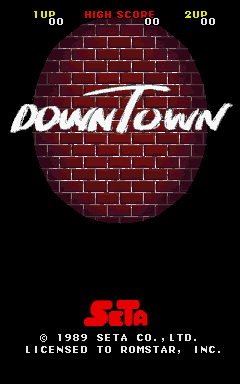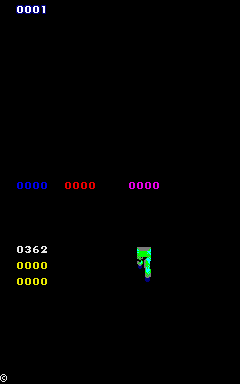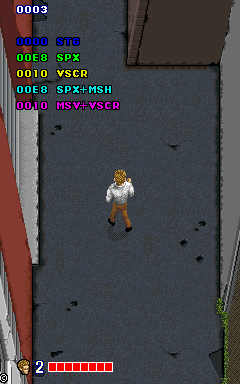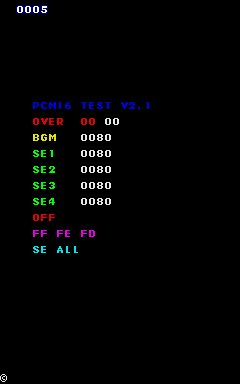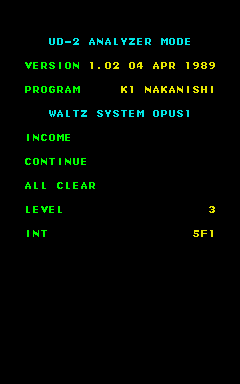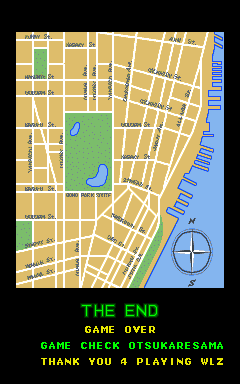DownTown
| DownTown |
|---|
|
Also known as: Mokugeki (JP)
|
DownTown is an unremarkable top-down beat 'em up, but at least there's some interesting stuff hidden inside.
Contents
Debug Functions
Sales Screen Debug
To enable the debug functions for this section...
- Set the Sales dip switch to "Japan Only". This will enable the Sales / Export notice.
- On the Sales / Export notice screen, press 1P Punch x3, then press 1P Kick x10.
- Hold 1P Punch + 1P Kick and insert a coin in Slot 1.
Note that only the first debug screen is enabled by default: To access the other three, put the following code in MAME's Downtown.xml cheat file:
<cheat desc="Change Coin Debug Mode">
<parameter>
<item value="0x0001">Character Debug</item>
<item value="0x0003">Stage Debug</item>
<item value="0x0005">PCM16 Test</item>
</parameter>
<script state="run">
<action>maincpu.pw@FFF86A=param</action>
</script>
</cheat>
Unfortunately, most of the functions seem to have been dummied out. This was presumably the main UD2 debug menu, but all of the text is missing and none of the player's input does anything. The player is effectively stuck on this screen until the machine is reset.
This is the remains of a character debugger. The only thing here that works is the white timer in the lower-left corner.
This stage debugger actually works a bit. The variables on screen display the player and camera's current position. To advance to the next area, get to the end of the current area and press 1P Start. Unfortunately, if the player presses 1P Start at the end of Stage 1, they're taken to the map screen with no way out.
This is the PCM16 test screen. It doesn't work. Thank you.
UD2 Test Mode
To enable a stage select feature, do the following:
- Set the Sales dip switch to "Japan Only". This will enable the Sales / Export notice.
- On the Sales / Export notice screen, press 1P Punch x3, then press 1P Kick x10.
- Start a new game. Hold 1P Punch + 1P Kick until the pre-game sequence ends.
The only two options that do anything on this menu are "Stage" and "Area". "Waltz" is just another timer.
UD2 Analyzer Mode
To access an analyzer screen, hold 2P Start and input the following button sequence:
1P Punch, 1P Kick, 1P Punch, 1P Kick, 1P Punch, 1P Kick,
1P Kick, 1P Punch, 1P Kick, 1P Punch, 1P Kick, 1P Punch, 1P Kick, 1P Punch,
1P Punch, 1P Kick
Wait for the title screen to fade and this screen should appear. "Income", "Continue, and "All Clear" don't seem to work properly, but "Level" is the raw value of the game's difficulty dip switch. "INT" is yet another game timer.
Press 1P Punch or 1P Kick to exit this screen.
Hidden Message
The following message is in the main CPU at 0x7FF00:
################ # # # UD-2 / TAM. # # # # Sep 13 1988 # # # # Programmed # # by # # Waltz System # # # # Thanks to # # MTY # # BLUE & NAG # # GOBLIN SOUND # # # ################
High Score Messages
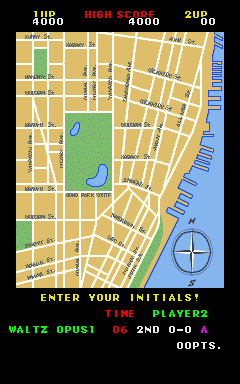
There are eleven names that a player can enter into the high score screen. These names play a sound effect and display a secret message. They are as follows:
| Name | Message | Sound | Notes |
|---|---|---|---|
| SEX | N/A | Either changes player's name to WLZ (1P) or blanks the player's name (2P). | |
| WLZ | WALTZ OPUS1 | Hold 1P Start + 2P Start while entering the name to change the message to "K1 JAN 1989". This only works for Player 1. | |
| DRA | DRANEKO IKUME | ||
| MTY | SEXY COMPUTER | MTY is Noboru Miyanari, a programmer who previously worked on another of Seta's games, Twin Eagle. | |
| BLS | SEXY BLUE | "Blue" appears in the game's credits under "Attribute Data." Whatever that means. | |
| ASA | KUMURIN DAO! | Kumurin Asako is one of the game's designers. | |
| GOB | GOBLIN SOUND | Goblin Sound is credited for the game's music. | |
| MYK | KASAZY CHAN! | Kasazy Miyuki is another of the game's designers. | |
| WAP | ESPRIT | ||
| SAL | SNAPPY UKI! | ||
| TAD | TAD GO GO GO |
Placeholder Ending
What appears to be a placeholder ending is present in the game's code. Put the following code in downtown.xml and activate it to see the credits on the stage results screen:
<cheat desc="Placeholder Ending">
<script state="run">
<action>maincpu.mw@0895D0=11FC</action>
<action>maincpu.mw@089602=11CA</action>
<action>maincpu.mw@08964E=117E</action>
</script>
<script state="off">
<action>maincpu.mw@0895D0=0F92</action>
<action>maincpu.mw@089602=0F60</action>
<action>maincpu.mw@08964E=0F14</action>
</script>
</cheat>
Data Labels
There are a number of data labels in the game ROM. Not especially interesting, but here we are.
| Address | Text | Address | Text | Address | Text | ||
|---|---|---|---|---|---|---|---|
| 0x002BE | TAM_STUP1_BB_END |
0x04000 | ## ANIME DATA ## |
0x05FB2 | ANIME DATA END | ||
| 0x10000 | OBJ BK ADR TABLE |
0x11F90 | # OBJ BK DATA. # |
0x23892 | OBJ BK DATA END | ||
| 0x238A2 | ### FIO DATA ### |
0x250B2 | # FIO DATA END # |
0x30000 | _SG1 DATA TABLE_ | ||
| 0x3FE10 | _SG1 DATA END _ |
0x40000 | BK-DATA AREA/001 |
0x40010 | STG CHR ADDR TBL | ||
| 0x40A70 | STG CHR TBL END! |
0x40A80 | STG COL ADDR TBL |
0x6B320 | FIX GEN DATA END | ||
| 0x70000 | _SG2 DATA TABLE_ |
0x7FE10 | _SG2 DATA END _ |
0x8090C | TAM_STUP2_END___ |
References
- Pages missing developer references
- Games developed by Seta
- Pages missing publisher references
- Games published by Taito
- Games published by Romstar
- Arcade games
- Pages missing date references
- Games released in 1989
- Games released in April
- Games released in March
- Games with hidden developer messages
- Games with hidden developer credits
- Games with unused graphics
- Games with debugging functions
- Games with hidden level selects
Cleanup > Pages missing date references
Cleanup > Pages missing developer references
Cleanup > Pages missing publisher references
Games > Games by content > Games with debugging functions
Games > Games by content > Games with hidden developer credits
Games > Games by content > Games with hidden developer messages
Games > Games by content > Games with hidden level selects
Games > Games by content > Games with unused graphics
Games > Games by developer > Games developed by Seta
Games > Games by platform > Arcade games
Games > Games by publisher
Games > Games by publisher > Games published by Romstar
Games > Games by publisher > Games published by Square Enix > Games published by Taito
Games > Games by release date > Games released in 1989
Games > Games by release date > Games released in April
Games > Games by release date > Games released in March
